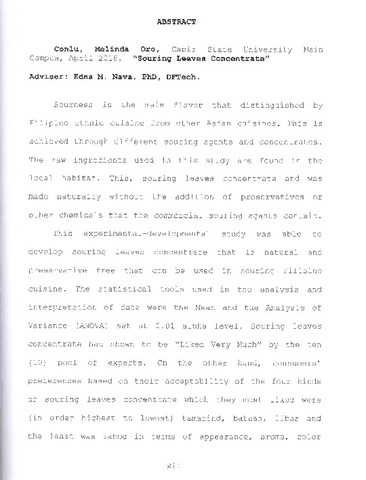Souring leaves concentrate
| dc.contributor.advisor | Nava, Edna M. | |
| dc.contributor.author | Conlu, Melinda O. | |
| dc.coverage.spatial | Capiz | en |
| dc.date.accessioned | 2024-02-21T07:29:16Z | |
| dc.date.available | 2024-02-21T07:29:16Z | |
| dc.date.issued | 2018-03 | |
| dc.identifier.citation | Conlu, M. O. (2018). Souring leaves concentrate [Doctoral dissertation, Capiz State University Main Campus]. CAPSU Institutional Repository. | en |
| dc.identifier.uri | https://repository.capsu.edu.ph/handle/123456789/110 | |
| dc.description.abstract | Sourness is the main flavor that distinguished by Filipino ethnic cuisine from other Asian cuisines. This is achieved through different souring agents and concentrates. The raw ingredients used in this study are found in the local habitat. This, souring leaves concentrate and was made naturally without the addition of preservatives or other chemicals that the commercial souring agents contain. This experimental-developmental study was able to develop souring leaves concentrate that is natural and preservative free that can be used in souring Filipino cuisine. The statistical tools used in the analysis and interpretation of data were the Mean and the Analysis of Variance (ANOVA) set at 0.01 alpha level. Souring leaves concentrate had shown to be "Liked Very Much" by the ten (10) pool of experts. On the other hand, consumers' preferences based on their acceptability of the four kinds of souring leaves concentrate which they most liked were (in order highest to lowest) tamarind, batuan, libas and the least was labog in terms of appearance, aroma, color and sourness and in terms of aroma, flavor, taste and sourness when it was applied to fish sinigang. Difference in the sensory qualities of the product revealed that there were no significant differences among the four souring leaves concentrates in terms of appearance, aroma, color and sourness as evaluated by experts but according to the 100 consumers/evaluators there were significant differences in the sensory qualities in terms of aroma, flavor, taste and sourness when the four souring concentrates were applied to fish sinigang and in favor of tamarind leaves, batuan leaves, and libas leaves respectfully. These three (3) souring leaves are a good alternative when one is not in season or available. The results indicated a strong recommendations for utilization and commercialization of the product. | en |
| dc.language.iso | en | en |
| dc.publisher | Main Campus, Capiz State University | en |
| dc.rights | * | |
| dc.rights.uri | * | |
| dc.subject | Souring leaves | en |
| dc.subject | Concentrates | en |
| dc.subject.lcsh | Leaves | en |
| dc.subject.lcsh | Drink concentrates | en |
| dc.title | Souring leaves concentrate | en |
| dc.type | Dissertation | en |
| dc.contributor.chair | Nava, Edna M. | |
| dc.contributor.committeemember | Villarruz, Ma. Dorothee J. | |
| dc.contributor.committeemember | Yap, Ma. Consuelo Y. | |
| dc.contributor.committeemember | Olano, Leila O. | |
| dc.contributor.committeemember | Sustento, Fatima P. | |
| thesis.degree.discipline | Industrial Education | en |
| thesis.degree.grantor | Main Campus, Capiz State University | en |
| thesis.degree.level | Doctoral | en |
| thesis.degree.name | Doctor of Education | en |
| thesis.degree.department | College of Education | en |

